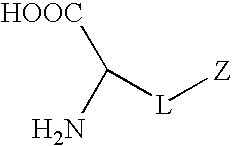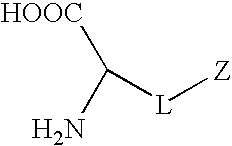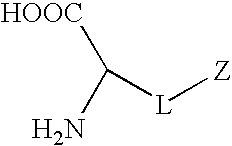Synthetic non-fouling amino acids
a technology of amino acids and amino acids, applied in the field of amino acids, can solve the problems of short in vivo life of materials, catastrophic device failure, and devices susceptible to fouling, and achieve the effects of reducing thrombogenesis, reducing fouling, and improving biocompatibility
- Summary
- Abstract
- Description
- Claims
- Application Information
AI Technical Summary
Benefits of technology
Problems solved by technology
Method used
Image
Examples
example 1
Proposed Synthesis of Carboxybetaine Amino Acid
[0097]
[0098]A carboxybetaine amino acid will be synthesized by the reaction of compound 1 (R1=Formoc (9H-(f)luoren-9-yl(m)eth(o)xy(c)arbonyl group) and R2=tert-Butyl group) and β-propiolactone. β-Propiolactone (12 mmol) in 10 mL dried acetone will be added dropwise to a solution of compound 1 (10 mmol) dissolved in 50 mL anhydrous acetone. The reaction mixture will be stirred under nitrogen protection at 15° C. for about 5 h. The white precipitate will be washed with 50 mL anhydrous acetone and 100 mL anhydrous ether. The product will be dried under reduced pressure to obtain the final product. The product will be kept in a dessicator at 2-8° C. before deprotection and polymerization.
example 2
Proposed Synthesis of Peptides Containing Zwitterionic Pendant Groups
[0099]Peptide containing pendant groups N,N-dimethyl tertiary amino will be synthesized by solid Fmoc solid-phase peptide synthesis. The peptide (with 50 mmol equiv N,N-dimethyl tertiary amino groups), ethyl 6-bromohexanoate (55 mmol), and acetonitrile (25 mL), will be added into a 100-mL round-bottom flask. The mixture will be stirred under a nitrogen atmosphere for five days at 45° C. The solvent will be removed on a rotary evaporator under reduced pressure. The peptide will be purified by dialysis for several times using deionized water. After dialysis, the peptide will be lyophilized and dried under reduced pressure. The peptide will then be hydrolyzed in a mixed solvent of methanol and water (1:1 ratio) and NaOH (1 M) for 2 hours at room temperature. The products will be dialyzed and lyophilized.
PUM
| Property | Measurement | Unit |
|---|---|---|
| pH | aaaaa | aaaaa |
| length | aaaaa | aaaaa |
| hydrogen bond | aaaaa | aaaaa |
Abstract
Description
Claims
Application Information
 Login to View More
Login to View More - R&D
- Intellectual Property
- Life Sciences
- Materials
- Tech Scout
- Unparalleled Data Quality
- Higher Quality Content
- 60% Fewer Hallucinations
Browse by: Latest US Patents, China's latest patents, Technical Efficacy Thesaurus, Application Domain, Technology Topic, Popular Technical Reports.
© 2025 PatSnap. All rights reserved.Legal|Privacy policy|Modern Slavery Act Transparency Statement|Sitemap|About US| Contact US: help@patsnap.com



